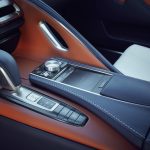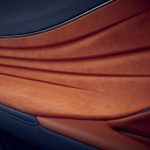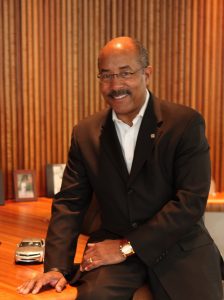“The world would be a sad place for me, without great design†–
Gerry McGovern.
Modern automotive design is, by necessity, high-tech and computer-led – leading to the belief that the human touch has largely been lost. But it is no coincidence that the imaginative mind behind one of the most successful car marques in existence takes influence from beyond the computer screen in order to design cars that provoke thought, interest, emotion and affection.
The Range Rover is just such a car. Launched in its original guise in 1970, it truly deserves to be called a ‘design icon’ – a status it has achieved through four model generations, the latest of which has even been hailed as ‘possibly the best car ever made’.
And now, as Range Rover celebrates its 45th anniversary, Land Rover’s Design Director and Chief Creative Officer Gerry McGovern gives an insight into five objects that have inspired and influenced the way in which he approaches his work.
1. Round Café, Coventry
This cylindrical café, which opened in the late 1950s, was a symbol of the modernist design philosophy introduced by Coventry town planner Donald Gibson, and has been regarded as a city centre landmark ever since.
The building, like many built in Coventry at the time, stood as a symbol of post-war optimism. Gerry says: “During the 1960s, the whole city centre was really modern, with mosaic tiling and large expanses of glass – most of the buildings in the town centre were forward thinking.
“My mother worked in the café for a while and I used to sit in there as a child. It felt like being in a spaceship. So I was introduced to this world of modernism and futuring from a very young age, which is something that has always stayed with me.â€
2. Eames lounge chair
The iconic Eames Lounge Chair was designed by Charles and Ray Eames for the Herman Miller furniture company in 1956. The chair’s unique shape, exposed structure and base materials of molded plywood and leather is said to be inspired by a baseball mitt.
The Eames chair has been a design favourite of Gerry’s for many years, representing a timeless piece that has both utility and purpose at its core. Gerry says: “It is perhaps an obvious choice for a designer to make, however it’s so good and continues to give me pleasure, which is what ultimately all good design should have the ability to do. For me, it’s a piece of design that is still relevant today.
“The Eames chair has certain values that are important to me as a designer. For example, being true to materials. The fact that, rather than covering up the structure, the designers chose to celebrate it. However, by continually refining and updating the materials and finishes, as well as improving the quality of construction with more contemporary materials, softer leathers and lighter woods, means that it’s still as relevant today as the day it was designed.â€
3. Josef Albers – ‘Never Before I’ series
German-born Josef Albers was an artist and teacher who specialised in painting, printmaking, murals and architecture. After emigrating to America in the 1930s, Albers was regarded as an important influence on generations of younger artists and was credited as an innovator in the fields of Op art and Colour Field painting.
The clarity and precision of Alber’s work is of particular significance to Gerry, he says: “Albers is recognised as one of the world’s greatest modernist printmakers. To me, the beauty lies in the precision of each colour against the other. There is absolute clarity in his work.
“One of the reasons why I admire Albers so much is the precision that he achieved through silkscreen printing, which meant he could create perfect lines of connecting colour. The colours are so vibrant, so rich. I never tire of his work – I bought my first collection by Albers more than 15 years ago and while I’ve sold many other artists work over the years, I’ve always kept the Albers.
“When creating an initial vehicle design, you start with the fundamentals, which are optimized volume and proportions and followed on by surfacing and detail. There is a sense of graphic design and symbolism in a lot of my favourite art, Albers’ printmaking is a perfect example.â€
4. Kaufmann Desert House, Palm Springs, California
Designed by Richard Neutra in 1946, the Kaufmann House is located in Palm Springs, California. It was created for the businessman and philanthropist Edgar Kaufmann and was purposefully designed to sit in juxtaposition with the surrounding mountains. It is seen as a prime example of modernist architecture.
The design aesthetic particularly resonated with Gerry, he says: “The Kaufmann House has that sense of bringing the outside in, which is something that we deliberately tried to incorporate with the inclusion of the panoramic roof on our Range Rovers.
“Many of our customers are being chauffeured through cities and want to look up and be able to take in their surroundings. We felt that it was important to introduce the large glass roof so we could bring a sense of the environment into the vehicle and thus create a sense of occasion.â€
5. Patek Philippe Calatrava watch
Since 1851, Patek Philippe has produced some of the world’s greatest timepieces and its unpretentious, yet sophisticated designs have been a mainstay throughout its history. Gerry owns two examples of the Swiss ultra-luxury watch manufacturer’s work – the Nautilus and Calatrava. He says: “The Calatrava particularly represents, in my view, a masterclass in simplicity and sophistication. It’s as much about what it doesn’t say, as what it does say. It’s a beautiful thing – the notion of ‘less is more’ is a fundamental part of its design philosophy. Every detail on the watch is doing a job.â€
Gerry concludes: “All five of these objects have the ability to connect on an emotional level. For me, emotional design has three key components. The first is visceral – when you look at it do you desire it. The second is behavioral – when you use it does it do what it’s meant to do. And finally, reflective – once you have experienced it, does it continue to excite. To me, Range Rover epitomizes all three of these components.â€
Gerry McGovern is Design Director and Chief Creative Officer for Land Rover. After completing a degree in industrial design at Coventry University, McGovern studied for a Masters at the Royal College of Art in London, specialising in automotive design. His early career took in stints at Chrysler, Peugeot and Rover Group, where he was lead designer of the critically acclaimed MGF sports car, Land Rover Freelander and third generation Range Rover.
After a spell at Ford Motor Company heading up Lincoln-Mercury, McGovern returned to the UK to run a design consultancy in London before rejoining Land Rover in 2004 as Director, Advanced Design. He was appointed Land Rover Design Director in 2006 and his position has since grown to include the role of Chief Creative Officer and he is an Executive member of the Jaguar Land Rover Board.












